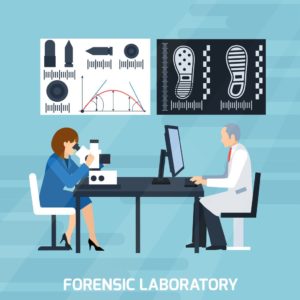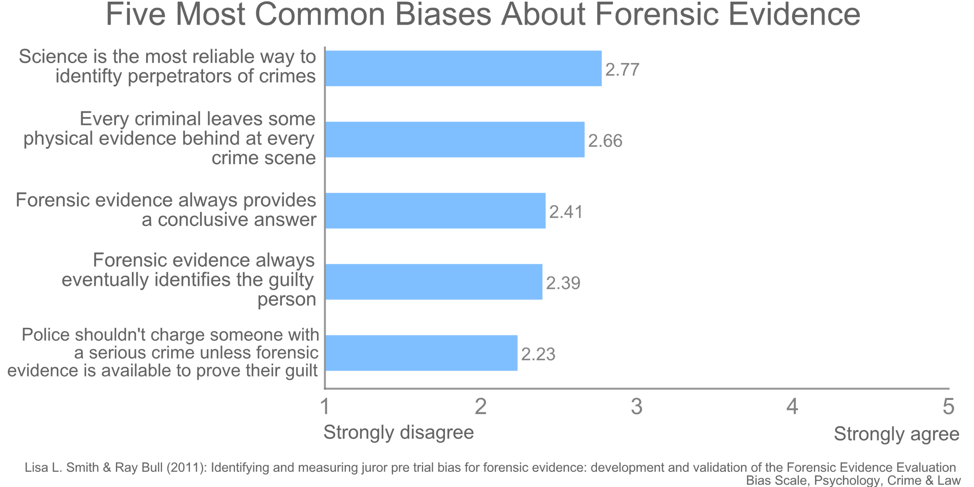By Dr. Ken Broda Bahm:

We all recognize the scene from a crime drama. Sometime late at night, under the dim lights of the state’s forensic lab, the results emerge from the sophisticated lab equipment: It’s a match! There is now no doubt whatsoever that we’ve found the killer. In the genre of criminal process drama, that moment is compelling because it plays to an attitude about science suggesting that we are now equipped with tools that are free from the frailties of human recollection and subjectivity, and the facts themselves are able to speak to us directly in a way that is unambiguous and unerring. Of course, that isn’t quite true, but that attitude can come into play, not only in criminal cases, but in every case that includes scientific evidence. Often called the “CSI effect,” the attitude is defined by heightened expectations for the value of forensic science, even to the point of downplaying other more common forms of proof.
The existence and extent of this attitude is often a point of contention among trial consultants and attorneys. Those who see it as just a media effect that comes from watching too many crime dramas tend to downplay it: People know it is entertainment, and in our fragmented media market, it is not as though everyone is watching these shows. But those who see it as a broader attitude recognize that there is some reality behind the “CSI Effect.” Understanding and measuring that attitude can be essential in the criminal arena, particularly when you don’t have unambiguous DNA evidence. In a civil case including scientific evidence on, for example, medical diagnosis, product dangers, or environmental processes, it can also be important to know when people might be bringing unrealistic expectations into the courtroom. In this post, I’ll take a brief look at what a handful of recent studies have to say about this bias.
The Bias is Real
Potential jurors will often have some clear attitudes toward forensic evidence. Researchers (Smith & Bull, 2012) have identified some of the most common biases:

It is reassuring that, looking at the averages at least, people are more likely to disagree than to agree with these idealized statements about forensic science. At the same time, the opinions vary widely and it is important in voir dire to find out who is inclined to believe and who isn’t.
And It Does Have an Effect on Outcomes
Naturally, jurors can moderate attitudes like that in response to the evidence and advocacy at trial. At the same time, the expectations they have going into the trial are likely to matter. An Australian team (Goodman-Delahunty & Tait, 2017) for example, used a simulated terrorism trial in order to see how these attitudes would influence reactions to an immersive crime-scene animation. “Mock jurors with more elevated expectations about forensic scientific evidence,” they found, “placed more trust in this evidence, were more persuaded of its value, or scrutinised its content less thoroughly than those who did not share these expectations.”
But it Doesn’t Fully Exclude Other Evidence
Emphasizing the hard science, of course, does not mean the other evidence is ignored. One recent study (Schweitzer & Nuñez, 2018 ) surveyed legal professionals to assess what kinds of evidence is common in homicide cases, and then tested the importance of the evidence to mock jurors. They found that evidence is important in the following order:
DNA
Fingerprints
The weapon
Video records
Crime-scene photos
Gunshot residue
Bodily secretions
Video confession
Testimony from a forensic expert
Eyewitness testimony
That is what the mock jurors claimed to value most. However, when given a folder of evidence and asked which evidence they wanted to learn more about, DNA stayed at the top, but confession and eyewitness testimony moved up to second and third place respectively.
And It Can Be Measured
Importantly, the research generally shows that this attitude is independent of viewing habits: It is a set of beliefs and not just a television-viewing pattern (Kim, Barak & Shelton, 2009). That set of beliefs can be measured.
The most common way of measuring is through a set of “Agree/Disagree” statements that are collectively called the “Forensic Evidence Evaluation Bias” or FEEB scale. Here are the statements:
Every crime can be solved with forensic science.
Every criminal leaves some physical evidence behind at every crime scene.
If forensic evidence suggests a defendant is guilty, this should be enough to convict even if other evidence (e.g., eyewitness testimony, alibi) suggests otherwise.
Forensic evidence always eventually identifies the guilty person.
Forensic evidence always provides a conclusive answer.
Science is the most reliable way to identify the perpetrators of crimes.
If no forensic evidence is recovered from a crime scene, it means the investigators did not look hard enough.
If there is no forensic evidence presented in a particular case, then the jury should not convict.
Police should not charge someone with a serious crime unless forensic evidence is available to prove their guilt.
If no forensic evidence is recovered from a crime scene, the defendant is probably innocent of the crime.
Typical of social science scales, these have some built-in redundancy, so in a criminal case, it may be effective to ask just a few of them, either in a questionnaire or in oral voir dire.
In a broader context, like a civil trial with scientific testimony, it is possible to adapt a few of them. For example:
Scientific evidence always provides a conclusive answer.
Science is the most reliable way to answer factual questions.
If no scientific evidence is offered on a question, it means the experts did not try hard enough.
Other Posts on Scientific Testimony:
- Yes, Virginia, There is a CSI Effect: Account for It in Your Science Case
- Follow 10 Simple Rules for Pretrial Research and Scientific Testimony
- Teach the Difference Between Science and Junk
Goodman-Delahunty, J., & Tait, D. (2017). CSI effects on jury reasoning and verdicts. In Juries, Science and Popular Culture in the Age of Terror (pp. 217-233). Palgrave Macmillan, London.
Kim, Y. S., Barak, G., & Shelton, D. E. (2009). Examining the “CSI-effect” in the cases of circumstantial evidence and eyewitness testimony: Multivariate and path analyses. Journal of Criminal Justice, 37(5), 452-460.
Lincoln, R., Southerland, A., & Jarrett-Luck, M. J. L. (2017). The persuasive powers of DNA: an experimental study in perceptions of expert evidence. GSTF Journal of Law and Social Sciences (JLSS), 3(2).
Schweitzer, K., & Nuñez, N. (2018). What Evidence Matters to Jurors? The Prevalence and Importance of Different Homicide Trial Evidence to Mock Jurors. Psychiatry, Psychology and Law, 1-15.
Smith, L. L., & Bull, R. (2012). Identifying and measuring juror pre-trial bias for forensic evidence: Development and validation of the Forensic Evidence Evaluation Bias Scale. Psychology, Crime & Law, 18(9), 797-815.